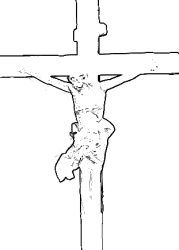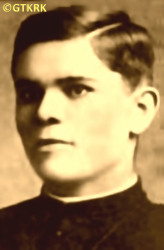Roman Catholic
St Sigismund parish
05-507 Słomczyn
85 Wiślana Str.
Konstancin deanery
Warsaw archdiocese, Poland
full list:
displayClick to display full list

searchClick to search full list by categories
wyświetlKliknij by wyświetlić pełną listę po polsku

szukajKliknij by przeszukać listę wg kategorii po polsku

Martyrology of the clergy — Poland
XX century (1914 – 1989)
personal data
surname
KULAWY
forename(s)
Adalbert (pl. Wojciech)

function
diocesan priest
creed
Latin (Roman Catholic) Church RCmore on
en.wikipedia.org
[access: 2014.09.21]
congregation
Congregation of Missionary Oblates of Mary Immaculate OMImore on
en.wikipedia.org
[access: 2013.05.19]
(i.e. Oblates)
diocese / province
Kielce diocesemore on
www.diecezja.kielce.pl
[access: 2012.12.28]
Gniezno and Poznań archdiocese (aeque principaliter)more on
www.archpoznan.pl
[access: 2012.11.23]
Philadephia archdiocese (US‐PA)more on
en.wikipedia.org
[access: 2022.09.31]
Polish province OMI
Polish provincial vicariate (vice‐province) OMI
St Boniface vicariate (later: Manitoba province)
northern France province OMI
date and place
of death
03.04.1942

Tuczępytoday: Tuczępy gm., Busko‐Zdrój pov., Holy Cross voiv., Poland
more on
en.wikipedia.org
[access: 2022.11.20]
details of death
During World War I 1914‐1918, in his Conshohocken parish, conducted a patriotic recruitment campaign for the forming Polish army.
After German and Russian invasion of Poland in 09.1939 and start of World War II, after start of German occupation forced by the Germans to leave Wronki.
In 02.1940 deported and resettled to German‐run Germ. Generalgouvernement (Eng. General Governorate). Tthis month the Germans displaced several thousand Poles from the Szamotuły poviat, including entire families, mostly of the intelligentsia — the rallying point was in Wronki, from where the deported were transported by freight trains to the General Government and thrown out in the towns of the Radom district.
Left out of the train in Jędrzejów n. Kielce.
Lived „in a tiny room”.
Perished few years later.
cause of death
exile
perpetrators
Germans
sites and events
GeneralgouvernementClick to display the description, Deportations from Reichsgau WarthelandClick to display the description, Reichsgau WarthelandClick to display the description, Ribbentrop‐MolotovClick to display the description, Pius XI's encyclicalsClick to display the description
date and place
of birth
16.04.1871

Leśnicatoday: Leśnica gm., Strzelce Opolskie pov., Opole voiv., Poland
more on
en.wikipedia.org
[access: 2021.08.12]
religious vows
15.08.1893 (temporary)
19.03.1895 (permanent)
presbyter (holy orders)
ordination
17.04.1898

positions held
1941 – 1942
resident — Tuczępytoday: Tuczępy gm., Busko‐Zdrój pov., Holy Cross voiv., Poland
more on
en.wikipedia.org
[access: 2022.11.20] ⋄ St John the Baptist RC parish ⋄ Stopnicatoday: Stopnica gm., Busko‐Zdrój pov., Holy Cross voiv., Poland
more on
en.wikipedia.org
[access: 2021.12.18] RC deanery
c. 1939 – 1941
resident — Jędrzejówform.: Andrzejów
today: Jędrzejów gm., Jędrzejów pov., Holy Cross voiv., Poland
more on
en.wikipedia.org
[access: 2021.06.07] ⋄ Holy Trinity RC parish ⋄ Jędrzejówform.: Andrzejów
today: Jędrzejów gm., Jędrzejów pov., Holy Cross voiv., Poland
more on
en.wikipedia.org
[access: 2021.06.07] RC deanery
c. 1930 – c. 1939
resident — Wronkitoday: Wronki gm., Szamotuły pov., Greater Poland voiv., Poland
more on
en.wikipedia.org
[access: 2021.06.20] ⋄ St Catherine the Virgin and Martyr RC parish ⋄ Wronkitoday: Wronki gm., Szamotuły pov., Greater Poland voiv., Poland
more on
en.wikipedia.org
[access: 2021.06.20] RC deanery — with breaks for healing trips to Gostyń (Philippine Fathers' monastery) and Piaski Wielkopolskie (Fatebenefratelli Fathers' monastery and „Marysin” hospital); also: hospital chaplain
1926 – c. 1930
administrator — Drawskotoday: Drawsko gm., Czarnków/Trzcianka pov., Greater Poland voiv., Poland
more on
en.wikipedia.org
[access: 2021.05.20] ⋄ Sacred Heart of Jesus RC parish ⋄ Czarnkówtoday: Czarnków gm., Czarnków/Trzcianka pov., Greater Poland voiv., Poland
more on
en.wikipedia.org
[access: 2021.06.20] RC deanery
1925
resident — Rogoźnotoday: Rogoźno gm., Oborniki pov., Greater Poland voiv., Poland
more on
en.wikipedia.org
[access: 2021.07.18] ⋄ St Vitus the Martyr RC parish ⋄ Rogoźnotoday: Rogoźno gm., Oborniki pov., Greater Poland voiv., Poland
more on
en.wikipedia.org
[access: 2021.07.18] RC deanery
1921 – 1925
resident — Wronkitoday: Wronki gm., Szamotuły pov., Greater Poland voiv., Poland
more on
en.wikipedia.org
[access: 2021.06.20] ⋄ St Catherine the Virgin and Martyr RC parish ⋄ Wronkitoday: Wronki gm., Szamotuły pov., Greater Poland voiv., Poland
more on
en.wikipedia.org
[access: 2021.06.20] RC deanery — also: prison chaplain
1913 – 1920
parish priest — Conshohockentoday: Montgomery Cou., Pennsylvania US‐PA state, United States of America
more on
en.wikipedia.org
[access: 2022.11.20] ⋄ Immaculate Conception of the Blessed Virgin Mary RC parish ⋄ Philadelphia RC archdiocese
1911 – 1913
parish priest — Clifton Heightstoday: Delaware Cou., Pennsylvania US‐PA state, United States of America
more on
en.wikipedia.org
[access: 2022.11.20] ⋄ Sacred Heart of Jesus RC parish ⋄ Philadelphia RC archdiocese
1906
leaving — Oblates OMI
1904 – 1905
superior of the house and parish priest — Winnipegtoday: Winniped city reg., Manitoba prov., Canada
more on
en.wikipedia.org
[access: 2022.11.20] ⋄ Congregation's house, Oblates OMI ⋄ Holy Spirit RC parish
1900 – 1904
friar — Winnipegtoday: Winniped city reg., Manitoba prov., Canada
more on
en.wikipedia.org
[access: 2022.11.20] ⋄ Congregation's house, Oblates OMI ⋄ Holy Spirit RC parish — chaplain to the Polish emigrants on the so‐called Western Territory
1898 – 1900
friar — Winnipegtoday: Winniped city reg., Manitoba prov., Canada
more on
en.wikipedia.org
[access: 2022.11.20] ⋄ Congregation's house, Oblates OMI ⋄ Immaculate Conception of the Blessed Virgin Mary RC church — missionary, e.g. in Cochrane, Canmore, Anthracite, Banff, Rabbit Hills (founder of the mission), among foreign–language immigrants, especially Poles, Ruthenians and Germans
1893 – 1898
student — Ottawatoday: Ontario prov., Canada
more on
en.wikipedia.org
[access: 2022.08.05] ⋄ St Joseph Higher Theological Seminary i.e. Scholasticate, Congregation's house, Oblates OMI
14.08.1892 – 15.08.1893
novitiate — Houthemtoday: Valkenburg aan de Geul, Limburg prov., Niederlands
more on
en.wikipedia.org
[access: 2022.11.20] ⋄ St Gerlach Congregation's house, Oblates OMI
1892
accession — Oblates OMI
1886 – 1892
pupil — Valkenburg aan de Geultoday: Valkenburg aan de Geul, Limburg prov., Niederlands
more on
en.wikipedia.org
[access: 2022.02.06] ⋄ Carolinum College — Minor Theological Seminary i.e. Juniorate (equiv. to gymnasium), Oblates OMI
sites and events
descriptions
Generalgouvernement: After the Polish defeat in the 09.1939 campaign, which was the result of the Ribbentrop‐Molotov Pact and constituted the first stage of World War II, and the beginning of German occupation in part of Poland (in the other, eastern part of Poland, the Russian occupation began), the Germans divided the occupied Polish territory into five main regions. In two of them new German provinces were created, two other were incorporated into other provinces. However, the fifth part was treated separately, and in a political sense it was supposed to recreate the German idea from 1915 (during World War I, after the defeat of the Russians in the Battle of Gorlice in 05.1915) of creating a Polish enclave within Germany. Illegal in the sense of international law, i.e. Hague Convention, and public law, managed by the Germans according to separate laws — especially established for the Polish Germ. Untermenschen (Eng. subhumans) — till the Russian offensive in 1945 it constituted part of the Germ. Großdeutschland (Eng. Greater Germany). Till 31.07.1940 formally called Germ. Generalgouvernement für die besetzten polnischen Gebiete (Eng. General Government for the occupied Polish lands) — later simply Germ. Generalgouvernement (Eng. General Governorate), as in the years 1915‐1918. From 07.1941, i.e. after the German attack on 22.06.1941 against the erstwhile ally, the Russians, it also included the Galicia district, i.e. the Polish pre‐war south‐eastern voivodeships. A special criminal law was enacted and applied to Poles and Jews, allowing for the arbitrary administration of the death penalty regardless of the age of the „perpetrator”, and sanctioning the use of collective responsibility. After the end of the military conflict of the World War UU, the government of the Germ. Generalgouvernement was recognized as a criminal organization, and its leader, governor Hans Frank, guilty of war crimes and crimes against humanity and executed. (more on: en.wikipedia.orgClick to attempt to display webpage
[access: 2024.12.13])
Deportations from Reichsgau Wartheland: After defeating Poland in 1939 a new province was created in Germany, Germ. Reichsgau Wartheland (Eng. Warta German Region) and defined as „indigenous German”, although in 1939 Germans constituted less than 10% of the total population there. In the same 1939, the national‐socialist leader of Germany, Adolf Hitler, announced the need to move Germans from the East to the Reich, mainly to the Germ. Reichsgau Wartheland. Another German leader, Robert Ley, stated, „In 50 years there will be a thriving German country where there will be neither a Pole nor a Jew! If someone asks me where they will be, I will answer: I don't know. In Palestine or in the Sahara desert, I don't care. But German people will live here!” Deportations began. By the end of 1939, c. 80 railway transports were sent to the Germ. Generalgouvernement (Eng. General Governorate) — a total of 87,883 people, mainly Poles and Jews. By 03.1941, over 280,000 people had been displaced. The deported had the right to take with them 12‐30 kg per person. They were given half an hour to pack. Over 60,000 Germans from Estonia, Latvia, Finland, later from other regions, were brought in to replace them. In 1941, c. 70,000 remaining Jewsa were displaced. (more on: pl.wikipedia.orgClick to attempt to display webpage
[access: 2022.11.20])
Reichsgau Wartheland: After the Polish defeat in the 09.1939 campaign, which was the result of the Ribbentrop‐Molotov Pact and constituted the first stage of World War II, and the beginning of German occupation in part of Poland (in the other, eastern part of Poland, the Russian occupation began), the Germans divided the occupied Polish territory into five main regions (and a few smaller). The largest one was transformed into Germ. Generalgouvernement (Eng. General Governorate), intended exclusively for Poles and Jews and constituting part of the so‐called Germ. Großdeutschland (Eng. Greater Germany). Two were added to existing German provinces. From two other separate new provinces were created. Greater Poland region was one of them, incorporated into Germany on 08.10.1939, by decree of the German leader Adolf Hitler (formally came into force on 26.10.1939), and on 24.01.1940 transformed into the Germ. Reichsgau Wartheland (Eng. Wartheland Reich Province), in which the law of the German state was to apply. The main axis of the policy of the new province, the territory of which the Germans recognized as the Germ. „Ursprünglich Deutsche” (Eng. „natively German”), despite the fact that 90% of its inhabitants were Poles, was Germ. „Entpolonisierung” (Eng. „Depolonisation”), i.e. forced Germanization. C. 100,000 Poles were murdered as part of the Germ. „Intelligenzaktion”, i.e. extermination of Polish intelligentsia and ruling classes. C. 630,000 were forcibly resettled to the Germ. Generalgouvernement, and their place taken by the Germans brought from other areas occupied by Germany (e.g. the Baltic countries, Bessarabia, Bukovina, etc.). Poles were forced to sign the German nationality list, the Germ. Deutsche Volksliste DVL. As part of the policy of „Ohne Gott, ohne Religion, ohne Priesters und Sakramenten” (Eng. „No God, no religion, no priest or sacrament”) most Catholic priests were arrested and sent to concentration camps. All schools teaching in Polish, Polish libraries, theaters and museums were closed. Polish landed estates confiscated. To further reduce the number of the Polish population, Poles were sent to forced labor deep inside Germany, and the legal age of marriage for Poles was increased (25 for women, 28 for men). The German state office, Germ. Rasse‐ und Siedlungshauptamt (Eng. Main Office of Race and Settlement) RuSHA, under the majesty of German law, abducted several thousand children who met specific racial criteria from Polish families and subjected them to forced Germanization, handing them over to German families. After the end of hostilities of World War II, the overseer of this province, the Germ. Reichsstatthalter (Eng. Reich Governor) and the Germ. Gauleiter (Eng. district head) of the German National Socialist Party, Arthur Karl Greiser, was executed. (more on: en.wikipedia.orgClick to attempt to display webpage
[access: 2024.06.21])
Ribbentrop‐Molotov: Genocidal Russian‐German alliance pact between Russian leader Joseph Stalin and German leader Adolf Hitler signed on 23.08.1939 in Moscow by respective foreign ministers, Mr. Vyacheslav Molotov for Russia and Joachim von Ribbentrop for Germany. The pact sanctioned and was the direct cause of joint Russian and German invasion of Poland and the outbreak of the World War II in 09.1939. In a political sense, the pact was an attempt to restore the status quo ante before 1914, with one exception, namely the „commercial” exchange of the so‐called „Kingdom of Poland”, which in 1914 was part of the Russian Empire, fore Eastern Galicia (today's western Ukraine), in 1914 belonging to the Austro‐Hungarian Empire. Galicia, including Lviv, was to be taken over by the Russians, the „Kingdom of Poland” — under the name of the General Governorate — Germany. The resultant „war was one of the greatest calamities and dramas of humanity in history, for two atheistic and anti‐Christian ideologies — national and international socialism — rejected God and His fifth Decalogue commandment: Thou shall not kill!” (Abp Stanislav Gądecki, 01.09.2019). The decisions taken — backed up by the betrayal of the formal allies of Poland, France and Germany, which on 12.09.1939, at a joint conference in Abbeville, decided not to provide aid to attacked Poland and not to take military action against Germany (a clear breach of treaty obligations with Poland) — were on 28.09.1939 slightly altered and made more precise when a treaty on „German‐Russian boundaries and friendship” was agreed by the same murderous signatories. One of its findings was establishment of spheres of influence in Central and Eastern Europe and in consequence IV partition of Poland. In one of its secret annexes agreed, that: „the Signatories will not tolerate on its respective territories any Polish propaganda that affects the territory of the other Side. On their respective territories they will suppress all such propaganda and inform each other of the measures taken to accomplish it”. The agreements resulted in a series of meeting between two genocidal organization representing both sides — German Gestapo and Russian NKVD when coordination of efforts to exterminate Polish intelligentsia and Polish leading classes (in Germany called «Intelligenzaktion», in Russia took the form of Katyń massacres) where discussed. Resulted in deaths of hundreds of thousands of Polish intelligentsia, including thousands of priests presented here, and tens of millions of ordinary people,. The results of this Russian‐German pact lasted till 1989 and are still in evidence even today. (more on: en.wikipedia.orgClick to attempt to display webpage
[access: 2015.09.30])
Pius XI's encyclicals: Facing the creation of two totalitarian systems in Europe, which seemed to compete with each other, though there were more similarities than contradictions between them, Pope Pius XI issued in 03.1937 (within 5 days) two encyclicals. In the „Mit brennender Sorge” (Eng. „With Burning Concern”) published on 14.03.1938, condemned the national socialism prevailing in Germany. The Pope wrote: „Whoever, following the old Germanic‐pre‐Christian beliefs, puts various impersonal fate in the place of a personal God, denies the wisdom of God and Providence […], whoever exalts earthly values: race or nation, or state, or state system, representatives of state power or other fundamental values of human society, […] and makes them the highest standard of all values, including religious ones, and idolizes them, this one […] is far from true faith in God and from a worldview corresponding to such faith”. On 19.03.1937, published „Divini Redemptoris” (Eng. „Divine Redeemer”), in which criticized Russian communism, dialectical materialism and the class struggle theory. The Pope wrote: „Communism deprives man of freedom, and therefore the spiritual basis of all life norms. It deprives the human person of all his dignity and any moral support with which he could resist the onslaught of blind passions […] This is the new gospel that Bolshevik and godless communism preaches as a message of salvation and redemption of humanity”… Pius XI demanded that the established human law be subjected to the natural law of God , recommended the implementation of the ideal of a Christian state and society, and called on Catholics to resist. Two years later, National Socialist Germany and Communist Russia came together and started World War II. (more on: www.vatican.vaClick to attempt to display webpage
[access: 2023.05.28], www.vatican.vaClick to attempt to display webpage
[access: 2023.05.28])
sources
personal:
www.k-k.plClick to attempt to display webpage
[access: 2021.12.19], historialubliniec.slask.plClick to attempt to display webpage
[access: 2022.11.20]
original images:
historialubliniec.slask.plClick to attempt to display webpage
[access: 2022.11.20], historialubliniec.slask.plClick to attempt to display webpage
[access: 2022.11.20]
LETTER to CUSTODIAN/ADMINISTRATOR
If you have an Email client on your communicator/computer — such as Mozilla Thunderbird, Windows Mail or Microsoft Outlook, described at WikipediaPatrz:
en.wikipedia.org, among others — try the link below, please:
LETTER to CUSTODIAN/ADMINISTRATORClick and try to call your own Email client
If however you do not run such a client or the above link is not active please send an email to the Custodian/Administrator using your account — in your customary email/correspondence engine — at the following address:

giving the following as the subject:
MARTYROLOGY: KULAWY Adalbert
To return to the biography press below:
 Click to return to biography
Click to return to biography









